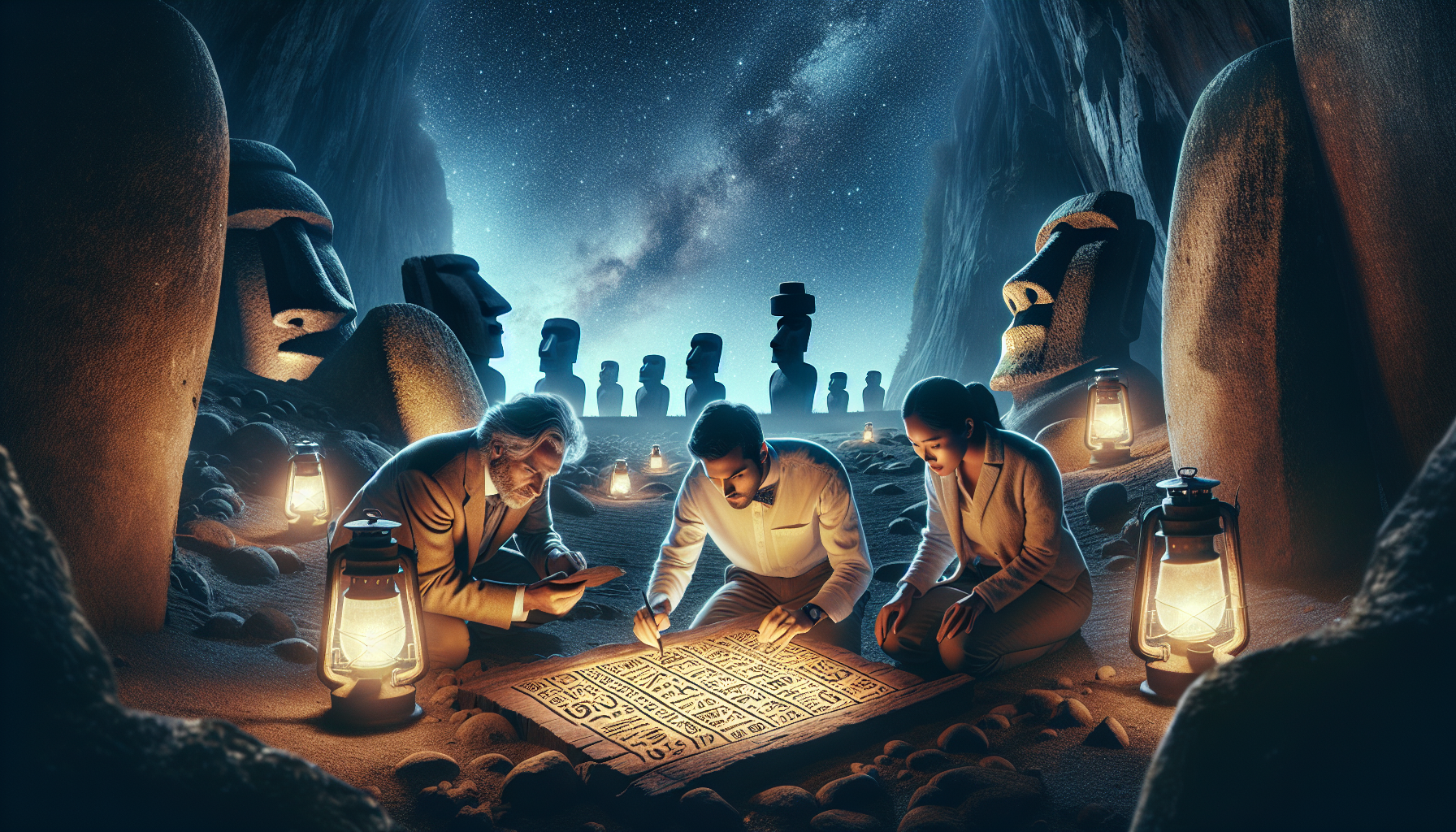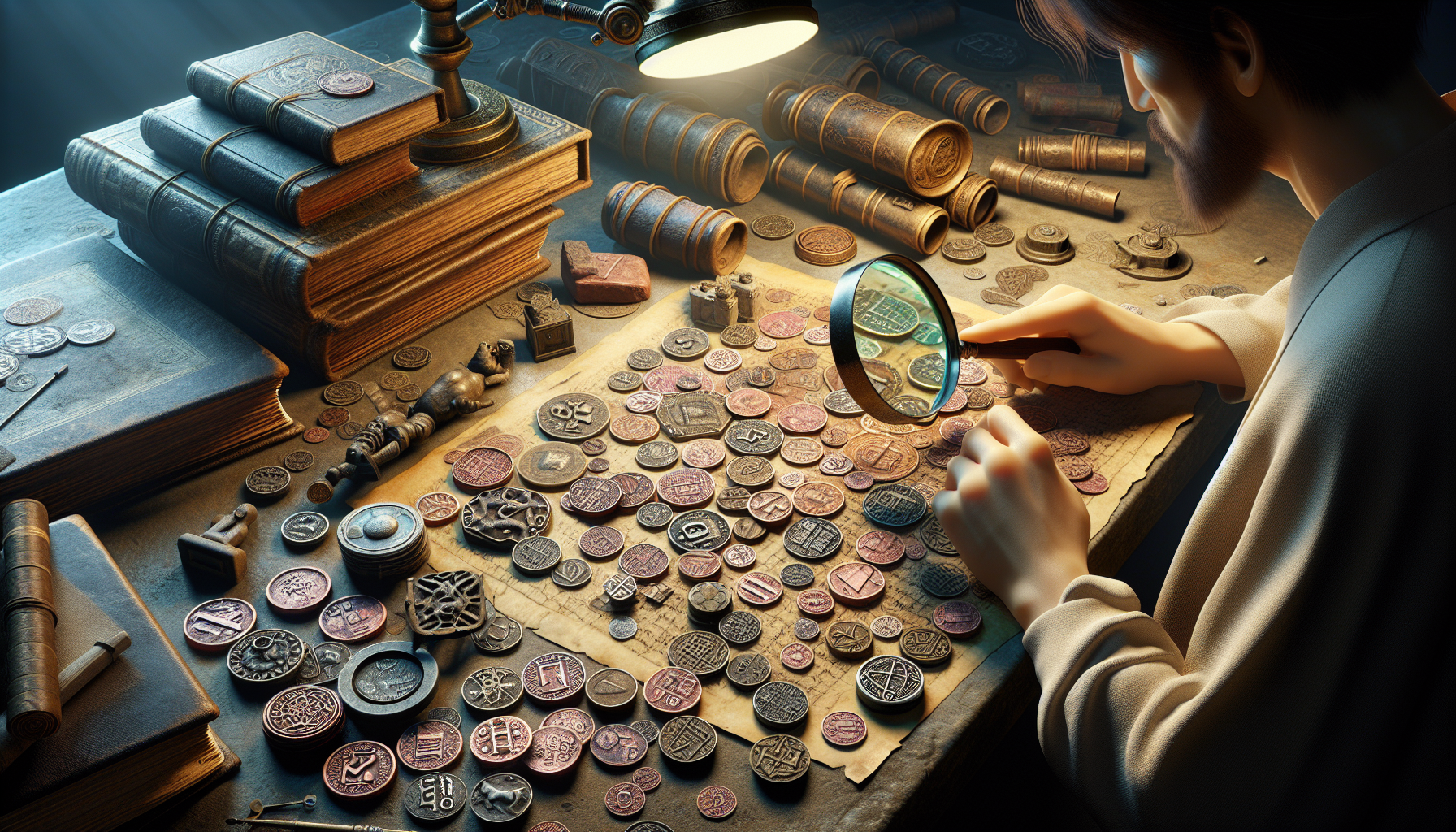In the heart of the vast Pacific Ocean lies a remote island shrouded in mystery and wonder—Easter Island, or Rapa Nui as the indigenous Polynesian people call it. Known worldwide for its iconic moai statues, this enigmatic island holds another captivating secret, one that has puzzled historians, linguists, and archaeologists for centuries: the Rongorongo script. This ancient system of glyphs, carved meticulously into wooden tablets, represents one of the few remaining undeciphered scripts of the world. As we embark on a journey to unravel the mysteries of Rongorongo, we delve into the depths of human history and culture, exploring the potential stories and knowledge locked within these symbols 🗿.
Rongorongo is not merely a relic of the past but a testament to the ingenuity and creativity of the Rapa Nui civilization. Its discovery in the 19th century by European explorers sparked immediate intrigue and a desire to understand a culture that developed in near isolation. What stories do these glyphs hold? Could they reveal insights into the spiritual, social, and political life of the Rapa Nui people? Despite numerous attempts by scholars worldwide, a definitive translation remains elusive, turning the script into one of history’s most captivating puzzles. This article seeks to explore the various theories and research efforts that have attempted to unlock the secrets of Rongorongo, offering a glimpse into the complex tapestry of human language and expression.
Throughout this exploration, we will examine the origins of the Rongorongo script, tracing back to when and how it was first discovered. We will navigate through the prevailing theories surrounding its purpose and meaning, from potential connections to other Polynesian languages to more speculative hypotheses that suggest extraterrestrial influences. Each theory, while unique, provides valuable insight into how scholars have approached this enigma over the years. We will also highlight the technological advancements and modern methodologies that have reignited interest in the script, offering fresh perspectives and potential breakthroughs in its interpretation.
Moreover, we will consider the cultural significance of preserving the Rongorongo script for future generations. As a crucial element of Rapa Nui heritage, understanding these glyphs could enrich our appreciation of the island’s cultural legacy and the broader Polynesian narrative. By engaging with local perspectives and acknowledging the importance of indigenous knowledge, we aim to foster a more holistic understanding of this script’s place in history. So, join us as we embark on this fascinating journey to unlock the mysteries of Rongorongo, where each discovery brings us closer to bridging the gap between past and present, offering new insights into the resilience and creativity of human civilization 🌍.
The Enigmatic Origins of Rongorongo
Rongorongo, the mysterious script of Easter Island, has intrigued researchers and linguists for generations. Discovered in the 19th century, this ancient script is one of the few undeciphered writing systems in the world. The name Rongorongo itself translates to “recite, chant out” in the Rapa Nui language, hinting at its possible use in oral traditions and rituals. Despite extensive study, the origins and purpose of Rongorongo remain shrouded in mystery, fueling ongoing debates and investigations.
Easter Island, or Rapa Nui as it is known locally, is located in the southeastern Pacific Ocean and is one of the most isolated inhabited islands in the world. The island is famous for its colossal stone statues, known as moai, which have long captivated archaeologists and tourists alike. However, the discovery of Rongorongo added a new layer of intrigue to the island’s rich cultural history. The script, carved into wooden tablets, seems to have emerged in a society already known for its sophisticated artistry and engineering. Understanding the script’s development could provide vital insights into the intellectual and cultural life of the Rapa Nui people.
The exact timeline of Rongorongo’s origin is a subject of much debate. Some scholars suggest it might have been inspired by European writing systems brought by explorers or missionaries, while others argue for an indigenous origin. It’s crucial to explore the environmental and societal factors that might have influenced the development of this script. Was it a tool for record-keeping, a religious text, or perhaps a political document? Each hypothesis provides a unique perspective on the social dynamics of the time. These questions highlight the need for a multidisciplinary approach, combining archaeology, anthropology, and linguistics, to unlock the secrets of Rongorongo.
The Structure and Characteristics of Rongorongo
Rongorongo is characterized by its intricate glyphs, which are carved in a unique form known as “reverse boustrophedon.” This method involves writing alternately left-to-right and right-to-left on successive lines. The glyphs are typically read from bottom to top, adding another layer of complexity to their interpretation. These glyphs depict a range of motifs, including humans, animals, plants, and geometric shapes, each potentially carrying symbolic meanings.
One of the fascinating aspects of Rongorongo is the absence of a clear relationship between the glyphs and the spoken Rapa Nui language. Unlike most writing systems, which directly represent phonetic sounds or syllables, Rongorongo may employ a logographic or ideographic approach. This means that each glyph could represent an entire word or concept rather than individual sounds. Such a system suggests a high level of abstraction and sophistication, indicating that the Rapa Nui had developed a complex means of communication.
Despite the challenges in decipherment, researchers have made some progress in understanding the structural elements of Rongorongo. By analyzing the repetition and patterns of glyphs, scholars have attempted to identify potential grammatical rules or thematic groupings. This work is complemented by comparisons with other ancient scripts, such as the Indus Valley script or the Linear A script of Crete. Check out the table below for a comparison between Rongorongo and other undeciphered scripts.
| Script | Region | Period | Key Characteristics |
|---|---|---|---|
| Rongorongo | Easter Island | 19th Century | Reverse Boustrophedon, Logographic/Ideographic |
| Indus Script | South Asia | 2600-1900 BCE | Possibly Logographic, Undeciphered |
| Linear A | Crete | 1800-1450 BCE | Syllabic, Undeciphered |
The Challenges in Deciphering Rongorongo
The road to deciphering Rongorongo is fraught with obstacles. One of the most significant challenges is the scarcity of surviving texts. Only about two dozen tablets and objects containing Rongorongo inscriptions have been found, and many of these are in poor condition. This limited corpus makes it difficult to establish a comprehensive understanding of the script’s structure and vocabulary. Furthermore, the lack of bilingual texts (akin to the Rosetta Stone for Egyptian hieroglyphs) severely hampers efforts to translate the glyphs.
Another complicating factor is the historical context in which Rongorongo was discovered. By the time European explorers documented the script, the Rapa Nui culture had undergone significant disruption due to disease, slavery, and colonial influences. As a result, much of the oral tradition that might have explained the script’s meaning was lost. This historical dislocation has left researchers reliant on fragmentary evidence and speculative hypotheses to piece together the story of Rongorongo.
Despite these challenges, modern technology offers new hope for deciphering Rongorongo. Techniques such as digital imaging and computational analysis allow researchers to examine the tablets in unprecedented detail. By using pattern recognition algorithms, scholars can identify recurring motifs and potential linguistic structures. Additionally, interdisciplinary collaboration with experts in Polynesian culture and history can provide valuable insights into the possible meanings behind the glyphs. For a visual exploration of these challenges and efforts, watch this insightful video on YouTube: “Unlocking the Secrets of Rongorongo” by Archaeology Channel.
The Cultural Significance of Rongorongo
Rongorongo is more than just a script; it is a key to understanding the cultural and spiritual life of the Rapa Nui people. The glyphs may have been used in religious ceremonies or as a means of recording genealogies and historical events. Understanding the script could reveal new aspects of the Rapa Nui’s worldview and their interactions with the natural and spiritual realms.
There is also a strong possibility that Rongorongo played a role in the island’s political structure. Some tablets contain sequences that suggest they may have been used to convey messages or decrees from the ruling elite. If this is true, deciphering Rongorongo could provide insights into the governance and social hierarchies of Easter Island. Additionally, it could shed light on the causes and consequences of the island’s ecological and societal changes over time.
The preservation and study of Rongorongo also have contemporary cultural significance. For the people of Rapa Nui, the script is a symbol of their ancestral heritage and identity. Efforts to decipher the script are not just academic endeavors; they are a way of reconnecting with a lost past and affirming cultural pride. As interest in Rongorongo continues to grow, it encourages a broader appreciation for the richness and diversity of Polynesian history and culture.
- Engage with the ongoing research by visiting exhibitions and museums that feature Rongorongo artifacts.
- Support digital projects that aim to create comprehensive databases of Rongorongo inscriptions.
- Participate in online forums and discussions to share insights and theories about the script.

Conclusion
Unlocking the mysteries of Rongorongo, the enigmatic script of Easter Island, is an intellectual journey that bridges the past and present, offering us a glimpse into the rich cultural tapestry of the Rapa Nui people. Through this exploration, we’ve journeyed into the heart of one of the world’s most remote islands, where the fusion of linguistic puzzles, archaeological insights, and cultural heritage converge to offer a captivating narrative.
To recapitulate, the origins of Rongorongo remain one of history’s most intriguing puzzles. Despite numerous theories, from early contact with other Polynesian cultures to the influence of pre-Columbian South American civilizations, the exact origins of the script continue to be debated among scholars. This script, carved into wooden tablets, holds potential insights into the Rapa Nui’s history, mythology, and social structure, yet remains largely undeciphered.
One of the crucial aspects of our exploration has been understanding the context in which Rongorongo was developed. As we delved into the socio-political climate of Easter Island, we observed how the island’s isolation played a pivotal role in shaping its unique cultural identity. The development of Rongorongo can be seen as a testament to the ingenuity and adaptability of the Rapa Nui, who created a complex written system in the confines of their remote environment.
Efforts to decode Rongorongo have been extensive yet challenging. Scholars have approached this task through various methodologies, including linguistic analysis, comparative studies with other Polynesian languages, and the application of modern technology. Despite these efforts, the script remains largely an enigma, with only a few interpretations gaining tentative acceptance within the academic community. This underscores the complexity of the script and the need for continued research and interdisciplinary collaboration.
In examining the significance of Rongorongo, it’s crucial to highlight its role in preserving the cultural heritage of the Rapa Nui. The script serves as a symbolic link to the island’s past, offering potential insights into the beliefs, traditions, and daily life of its people. As such, preserving and studying Rongorongo is not merely an academic endeavor but a cultural imperative that honors the legacy of the Rapa Nui ancestors.
The journey of deciphering Rongorongo is not just about uncovering the past; it is also about acknowledging the resilience and creativity of the Rapa Nui people. Their ability to develop such a script reflects their intellectual capacity and the importance they placed on recording and transmitting knowledge.
As we conclude this exploration, the importance of continued research cannot be overstated. Every effort to understand Rongorongo brings us closer to appreciating the full spectrum of human cultural expression. The potential insights that could be gained from unlocking this script are invaluable, not only for the Rapa Nui but for the broader understanding of human history and the diversity of written expression across cultures.
To our readers, the story of Rongorongo is an invitation to engage with the wonders of human creativity and resilience. It serves as a reminder of the vast potential that lies within our collective past, waiting to be uncovered and celebrated. We encourage you to delve deeper into this fascinating topic, share your thoughts, and participate in the ongoing conversation surrounding this ancient script. By doing so, you contribute to a broader appreciation and preservation of global cultural heritage.
In your pursuit of knowledge, consider the impact that understanding diverse cultures and histories can have on your worldview. Engaging with topics like Rongorongo encourages critical thinking and fosters a deeper appreciation for the intricate tapestry of human civilization.
In conclusion, the mysteries of Rongorongo invite us to embrace the unknown and appreciate the rich complexity of human culture. As we continue to explore and understand this script, we not only unlock the secrets of Easter Island but also reaffirm the enduring legacy of the human spirit’s quest for knowledge and understanding. Let’s embrace this journey together, share our insights, and contribute to preserving this invaluable piece of our shared history. 🌍
For further reading and exploration, consider visiting reputable sources such as:
1. The Easter Island Foundation www.islandheritage.org
2. The British Museum’s Easter Island Collection www.britishmuseum.org
3. The UNESCO World Heritage List – Rapa Nui whc.unesco.org
Let’s continue to explore, share, and celebrate the wonders of our world’s diverse cultural heritage.
Toni Santos is a visual cryptographer and artisan, weaving hidden meaning into every line, curve, and composition. His creations delve into the mysterious world of secret codes, symbolic alphabets, and invented languages, transforming visual art into a rich tapestry of communication beyond words.
Guided by a lifelong fascination with hidden knowledge and the power of symbols, Toni explores how meaning can be embedded, concealed, and rediscovered. From constructed glyphs to encoded illustrations, each piece he creates serves as a portal to a deeper layer of understanding — one that invites curiosity, interpretation, and wonder. His work bridges the intuitive with the intellectual, the mystical with the methodical.
With roots in handcrafted artistry and a background in visual semiotics, Toni fuses form and function to create works that whisper rather than shout. These are not just images — they are visual riddles, poetic encryptions, and artifacts of a language yet to be spoken.
As the creative mind behind Vizovex, Toni offers a space where art meets encryption, and viewers are invited to decode, reflect, and engage. Through symbolic design, visual lexicons, and explorations into constructed languages, he builds a universe where meaning is layered, intentional, and always slightly out of reach — waiting to be discovered.
His work is a tribute to:
The unseen languages that shape our perception
The art of hidden messages and symbolic systems
The thrill of decoding and the beauty of mystery
Whether you’re a language lover, a codebreaker at heart, or someone drawn to the enigmatic, Toni invites you to explore a world where expression transcends convention — one glyph, one message, one mystery at a time.





